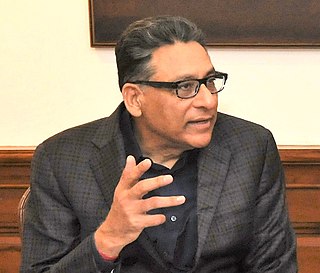Related Research Articles

A mainframe computer, informally called a mainframe or big iron, is a computer used primarily by large organizations for critical applications like bulk data processing for tasks such as censuses, industry and consumer statistics, enterprise resource planning, and large-scale transaction processing. A mainframe computer is large but not as large as a supercomputer and has more processing power than some other classes of computers, such as minicomputers, servers, workstations, and personal computers. Most large-scale computer-system architectures were established in the 1960s, but they continue to evolve. Mainframe computers are often used as servers.

NCR Voyix Corporation, previously known as NCR Corporation and National Cash Register, is an American software, consulting and technology company providing several professional services and electronic products. It manufactured self-service kiosks, point-of-sale terminals, automated teller machines, check processing systems, and barcode scanners.
Teradata Corporation is an American software company that provides cloud database and analytics-related software, products, and services. The company was formed in 1979 in Brentwood, California, as a collaboration between researchers at Caltech and Citibank's advanced technology group.

William Daniel Hillis is an American inventor, entrepreneur, and computer scientist, who pioneered parallel computers and their use in artificial intelligence. He founded Thinking Machines Corporation, a parallel supercomputer manufacturer, and subsequently was Vice President of Research and Disney Fellow at Walt Disney Imagineering.
Peter Pin-Shan Chen is a Taiwanese American computer scientist. He is a (retired) distinguished career scientist and faculty member at Carnegie Mellon University and Distinguished Chair Professor Emeritus at LSU. He is known for the development of the entity–relationship model in 1976.

Vinod Dham is an Indian-American engineer, entrepreneur, and venture capitalist. He is known as the 'Father of the Pentium Chip' for his contribution to the development of Intel's Pentium micro-processor. He is also a mentor and advisor, and sits on the boards of companies, including startups funded through his India-based fund Indo-US Venture Partners, where he is the founding managing director.

The DBC/1012 Data Base Computer was a database machine introduced by Teradata Corporation in 1984, as a back-end data base management system for mainframe computers. The DBC/1012 harnessed multiple Intel microprocessors, each with its own dedicated disk drive, by interconnecting them with the Ynet switching network in a massively parallel processing system. The DBC/1012 was designed to manage databases up to one terabyte in size; "1012" in the name refers to "10 to the power of 12".
M. Dale Skeen is an American computer scientist. He specializes in designing and implementing large-scale computing systems, distributed computing and database management systems.

Harry L. "Nick" Tredennick was an American manager, inventor, VLSI design engineer and author who was involved in the development for Motorola's MC68000 and for IBM's Micro/370 microprocessors. He held BSEE and MSEE degrees from Texas Tech University, and a Ph.D. in Electrical Engineering from the University of Texas at Austin. Tredennick was named a Fellow of the IEEE; the citation reads "For the design and implementation of the execution unit and controller of the MC68000 workstation microprocessor".
In computing, the term data warehouse appliance (DWA) was coined by Foster Hinshaw for a computer architecture for data warehouses (DW) specifically marketed for big data analysis and discovery that is simple to use and has a high performance for the workload. A DWA includes an integrated set of servers, storage, operating systems, and databases.

Greenplum is a big data technology based on MPP architecture and the Postgres open source database technology. The technology was created by a company of the same name headquartered in San Mateo, California around 2005. Greenplum was acquired by EMC Corporation in July 2010.

Michael Ralph Stonebraker is a computer scientist specializing in database systems. Through a series of academic prototypes and commercial startups, Stonebraker's research and products are central to many relational databases. He is also the founder of many database companies, including Ingres Corporation, Illustra, Paradigm4, StreamBase Systems, Tamr, Vertica and VoltDB, and served as chief technical officer of Informix. For his contributions to database research, Stonebraker received the 2014 Turing Award, often described as "the Nobel Prize for computing."

Vertica is an analytic database management software company. Vertica was founded in 2005 by the database researcher Michael Stonebraker with Andrew Palmer as the founding CEO. Ralph Breslauer and Christopher P. Lynch served as CEOs later on.
Chandrasekaran Mohan is an Indian-born American computer scientist. He was born on 3 August 1955 in Tamil Nadu, India. After growing up there and finishing his undergraduate studies in Chennai, he moved to the United States in 1977 for graduate studies, naturalizing in 2007. In June 2020, he retired from being an IBM Fellow at the IBM Almaden Research Center after working at IBM Research for 38.5 years. Currently, he is a visiting professor at China's Tsinghua University. He is also an Honorary Advisor at the Tamil Nadu e-Governance Agency (TNeGA) in Chennai and an advisor at the Kerala Blockchain Academy in Kerala.
The following outline is provided as an overview of and topical guide to computing:
Massively parallel is the term for using a large number of computer processors to simultaneously perform a set of coordinated computations in parallel. GPUs are massively parallel architecture with tens of thousands of threads.
Information technology (IT) is a set of related fields that encompass computer systems, software, programming languages, and data and information processing, and storage. IT forms part of information and communications technology (ICT). An information technology system is generally an information system, a communications system, or, more specifically speaking, a computer system — including all hardware, software, and peripheral equipment — operated by a limited group of IT users, and an IT project usually refers to the commissioning and implementation of an IT system. IT systems play a vital role in facilitating efficient data management, enhancing communication networks, and supporting organizational processes across various industries. Successful IT projects require meticulous planning, seamless integration, and ongoing maintenance to ensure optimal functionality and alignment with organizational objectives.
Presto is a distributed query engine for big data using the SQL query language. Its architecture allows users to query data sources such as Hadoop, Cassandra, Kafka, AWS S3, Alluxio, MySQL, MongoDB and Teradata, and allows use of multiple data sources within a query. Presto is community-driven open-source software released under the Apache License.

Michael (Mike) Papazoglou is a Greek/Australian emeritus professor, computer science researcher and author known for his contributions to 'Service-Oriented Computing'. His main research interests include Distributed computing, Database#Database management system, Big data, Service, Domain-specific language and Cloud computing. In more recent years he shifted his focus to pursuing Emerging technologies, Industrial engineering, Smart Applications and Smart Technology Solutions for Healthcare and Manufacturing.
References
- 1 2 3 4 5 6 7 8 "Stephen Brobst". site.teradata.com. Retrieved 2016-12-13.
- ↑ "UC Berkeley Department of Bioengineering — Bioengineering research and education at UC Berkeley". bioeng.berkeley.edu. Retrieved 2016-12-13.
- 1 2 "Teradata Leadership". www.teradata.com. Retrieved 2016-12-13.
- 1 2 "Stephen Brobst: Managing Partner Sampo Technologies & Systems". Promotional Speaker biography for TDWI Solution Summit. September 25, 2011. Archived from the original on April 26, 2012. Retrieved February 15, 2017.
- ↑ Tanning Technology Corporation (July 22, 1999). "Form S-1: Registration of Securities". US Securities and Exchange Commission. Retrieved February 15, 2017.
- ↑ "IBM Acquires Warehouse Software from NexTek". Press release. September 23, 1998 – via Computer Business Review.
- ↑ "Thinking Machines". Technology Review. November 1, 2006.
- 1 2 "Report on Networking and Information Technology" (PDF). Office of Science and Technology Policy – via National Archives.
- ↑ "PCAST President's Council of Advisors on Science and Technology". www.tvworldwide.com. Retrieved 2016-12-13.
- ↑ 2014 Top Chief Technology Officers
- ↑ "Big Data." In Information Systems and Information Technology, Volume 2 (Computing Handbook Set, Third Edition). Association for Computing Machinery, 2014
- ↑ Poe, Vidette, Patricia Klauer, Stephen Brobst (1997). Building a Data Warehouse for Decision Support. Prentice Hall PTR. ISBN 0-13-769639-6.
- ↑ Poe, Vidette, Patricia Klauer, Stephen Brobst (1999). Tworzenie Hurtowni Danych. Wydawnictwa Naukowo-Techniczne.
- ↑ USpatent 8818988,Brobst, Stephen A.; Brown, Douglas P.& Burger, Louis M.,"Database system having a regulator to provide feedback statistics to an optimizer",published 2014-08-26
- ↑ USpatent 8407180,Ramesh, Bhashyam&Brobst, Stephen A.,"Eliminating inner joins based on a temporal relationship constraint",published 2013-03-06
- ↑ USpatent 8332857,Brown, Douglas; Brobst, Stephen& Richards, Anitaet al.,"Database system having a regulator that performs workload regulation based on optimizer estimates",published 2012-12-11
- ↑ USpatent 8151269,Brown, Douglas; Brobst, Stephen& Richards, Anitaet al.,"Database system having a service level goal responsive regulator",published 2012-04-03
- ↑ USpatent 7882103,Brobst, Stephen A.,"Using point-in-time views to provide varying levels of data freshness",published 2011-02-01
- ↑ USpatent 7359906,Hargett, Kim Nguyen; Brobst, Stephen A.& Lessing, Pieteret al.,"Method for developing data warehouse logical data models using shared subject areas",published 2008-04-15
- ↑ USpatent 7167873,Brobst, Stephen A.; Naik, Ojustwin& Redd, Edwina R.,"Visual-modeling technique for use in implementing a database system",published 2007-01-23
- ↑ USpatent 5562104,Hochberg, Fred H.; Trustman, John W.& Hochberg, Benjamin A.et al.,"Measuring movement disorder",published 1996-10-08